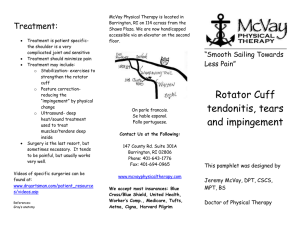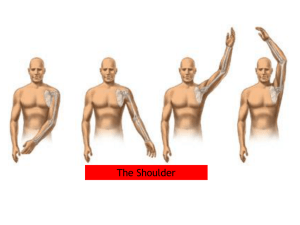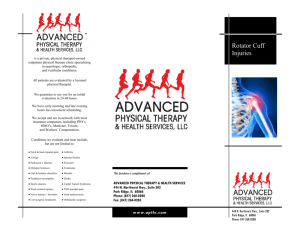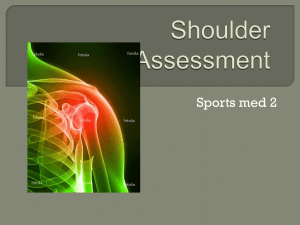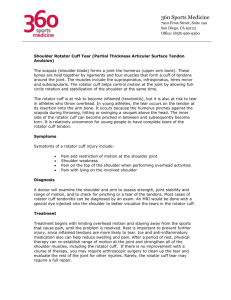Approach to the Hypotensive Patient
advertisement
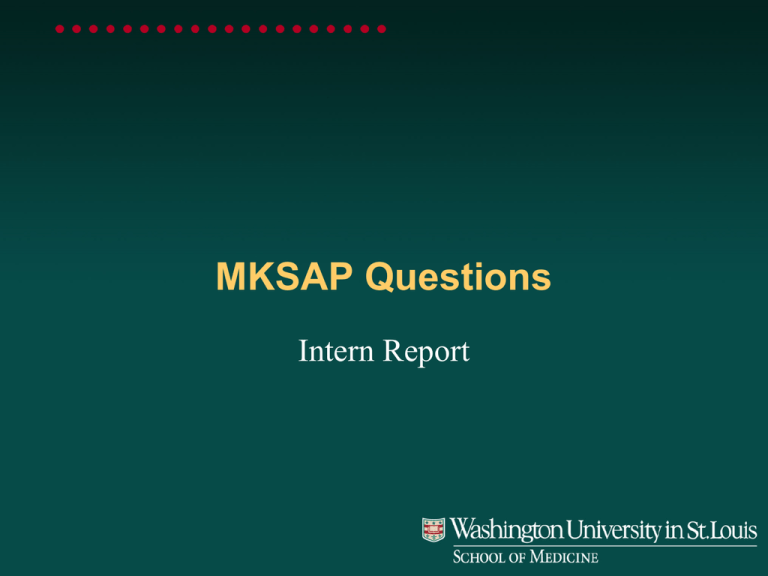
MKSAP Questions Intern Report General Internal Medicine – Question 72 A 47 y/o man is evaluated for right lateral shoulder pain. He has been pitching during batting practice for his son’s little league baseball team for the past 2 months. He has shoulder pain when lifting his arm overhead and also when lying on the shoulder while sleeping. Acetaminophen has not been helpful. On physical exam, he has no shoulder deformities or swelling. Range of motion is normal. He has subacromial tenderness to palpation, with shoulder pain elicited at 60 degrees of passive abduction. He also has pain with resisted midarc abduction but no pain with resisted elbow flexion or forearm supination. He is able to smoothly lower his right arm from a fully abducted position, and his arm strength for abduction and external rotation against resistance is normal. Which of the following is the most likely diagnosis in this patient? A. Adhesive capsulitis B. Bicipital tendonitis C. Glenohumeral arthritis D. Rotator cuff tear E. Rotator cuff tendonitis General Internal Medicine – Question 72 E. Rotator cuff tendonitis • inflammation of the supraspinatus and/or infraspinatus tendon that can also involve the subacromial bursa, common overuse injury – subacromial tenderness and impingement – Pain occurs with overhead reaching and when lying on the side – The passive painful-arc maneuver assesses the degree of impingement – Pain with resisted midarc abduction is a specific finding for rotator cuff tendonitis – Appropriate treatments include NSAIDs, ice, and exercise • Adhesive capsulitis (frozen shoulder): decreased range of shoulder motion resulting from stiffness rather than from pain or weakness • Bicipital tendonitis: overuse injury, tender bicipital groove, and anterior shoulder pain is elicited with resisted forearm supination or elbow flexion • Glenohumeral arthritis: related to trauma and the gradual onset of pain and stiffness over months • Torn rotator cuff: arm weakness, particularly with abduction and/or external rotation – A positive drop-arm test is a very specific but relatively insensitive method for diagnosing rotator cuff tear Approach to the Hypotensive Patient Etiologies of Shock Hypovolemic Cardiogenic Distributive Obstructive Combined “A significant reduction in tissue perfusion, Resulting in poor oxygen delivery to these tissues” SHOCK Physiology Physiologic Variable Preload Contractility Afterload Tissue Perfusion Clinical PCWP CI/CO SVR MV02 Hypovolemic Distributive Cardiogenic Obstructive COMBINED SHOCK PROBABLY MOST COMMON SHOCK Management-Basics Increase preload Increase contractility Increase/decrease afterload Increase oxygen delivery Oxygen Delivery= CO X ((1.34 x hemoglobin concentration x SaO2) + (0.0031 x PaO2)) Initial Evaluation What are the vital signs? Check BP in both arms Is the patient mentating well or confused? What has their urine output been? What is the BP trend? Reason for admission? Do they have IV access? Does the patient look well? Initial Evaluation-History History: rarely useful in the acute setting Food/medicine allergies Medication changes Immunosupressed states Hypercoagulable conditions Prexisting illnesses Recent procedures Initial Evaluation - Physical Exam Evidence of: Intravascular volume depletion Obstructive symptoms (RV heave, pulsus paradox) Irregular rhythm, murmurs, rubs, gallops Peritoneal signs, ascites Peripheral vasodilation (hyperemic skin) Peripheral vasoconstriction (cold, clammy skin) Decreased breath sounds While your neurons are firing… Get appropriate IV access Large bore IV vs. Central access Crash cart close by with: Levophed (Norepinephrine) Dopamine Vasopressin Atropine Amiodarone/BB How do we investigate this? All must be sent STAT CBC, Coag panel - evidence of blood loss BMP - evidence of lactic acidosis from tissue hypoperfusion Troponins ECG Echo - evidence of pump failure, RV dysfunction, pericardial tamponade Case 1 JB is a 75 y.o WM with hx of CAD, DM2, HTN admitted for chest pain/ischemic evaluation Initial ECG shows sinus bradycardia with 1st deg AVB (PR=200msec), no ST/TW∆es Beta blocker held, receives ASA/Lovenox HD # 1, nurse calls you with BP of 68/44 This is not what I signed up for!! Patient is oriented but lethargic Repeat BP is 65/42, HR 45 bpm Exam: no JVD, intravasc vol. depletion, obstructive sx IVF NS: wide-open Tele Review: sinus pauses 4 sec What is the diagnosis? COMPLETE HEART BLOCK To Pace Or Not.. Atropine 1 mg IV given HR increased to 65, BP increased to 85/55 Place TLC catheter Pacing pads applied Transcutaneous pacing at 65 bpm Transfer to CCU Dopamine Complete Heart Block - Summary Assess hemodynamics Look at escape rhythm Width of the QRS complex predicts location in AV node and response to atropine Narrow = higher location, better response to atropine Evaluate for ischemia-usually vagal mediated Anterior MI Inferior MI Are there any reversible etiologies such as medications, electrolytes, etc. Case 2 A.B is a 67 y.o AAM with hx of CKD, CHF, HTN, COPD admitted for cough, fevers CXR c/w LL PNA, initials vitals stable Treated with Rocephin + Azithro Sputum/blood cx pending On HD # 3, while on rounds, you notice patient to be somnolent and confused Should I run away now? STAT Vitals BP 85/50. HR 115. O2 sat = 89% RA Review of previous vitals show BP decreasing gradually during past 12 hours Fever up to 103.1 F o/n Exam c/w decrease BS at R base, warm hyperemic peripheral extremities ECG: Sinus tachy. No ST/TW changes WHAT IS THE LIKELY DIAGNOSIS? SEPSIS/SIRS Management IVF NS (wide-open) with TLC in place Repeat BP in 10 min: BP 75/60 after 1 liter NS, more lethargic Start pressors: Levophed (Norepinephrine) - increase SVR Let nursing staff know of likely ICU transfer Repeat BP on pressors BP 90/55, 85/55, 93/60 Send blood and urine cultures Send STAT labs including ABG, CBC, BMP, coag panel Which Antibiotics? Broaden coverage to include Pseudomonas, MRSA CTX:Cefepime :: GNB:GNB+Ps Unasyn:Zosyn :: GP/An/GN:GP/An/GN + Ps So…start with Vanc and Cefepime (Vancopime) Transfer to MICU Sepsis Protocol Applicable to ICU patients Goal directed resuscitation IVF guided by CVP – at least up to 10 mmHg Assess MAP – 65 mmHg Pressor support – usually levophed Vasopressin useful in profound acidemia Avoid dopamine in excessive tachy states Assess perfusion – Mixed Venous SV02 (70%) Transfusion of pRBCS to Hct >30% Addition of inotropic support (dobutamine) Read Early goal directed therapy or Sepsis guidelines Prior to MICU Case 3 J.R. is a 45 y.o. WM with hx of Crohns, being treated with TNF- therapy, and prednisone Admitted for increased N/V/D for 1 week No infectious precipitant identified You go the ER to see him and you note that his BP is 65/40, HR 115 He is mentating well though Evaluation Exam c/w dry mucous membranes, decreased skin turgor Repeat BP shows the same value What should you do? Fluids….fluids…fluids.. IVF NS: Aggressive rescucitation Pan-culture (risk of infection is high 2/2 concurrent immunosuprressive therapy) Ask about history of glucocorticoid tx Check for adrenal insufficiency Dosing stress-dose steroids: Hydrocortisone 100 mg IV q6h OR Dexamethasone 4 mg IV q6h – does not affect cortisol assay Case 4 D.F is a 54 y.o. WF with history of scleroderma, and secondary pulmonary hypertension, admitted for worsening ascites Being treated with diuretics and antibiotics for SBP On HD#4, nurse calls stating: “BP is 80/55, and she is complaining of chest pain and her breathing has become more labored” Based on this… What is the most likely diagnosis? Pulmonary Embolism What next? Vitals are same on repeat Exam c/w incr JVP, RV heave, mild facial plethora IVF/Access established Heparin gtt initiated for suspecting PE Repeat BP in 10 minutes - still 80/50 Transfer To ICU Is it ever “too much” fluid during resuscitation? Concept of LV/RV interdependence Pressor support Which one? Levophed preferred - less likely to cause tachy Dopamine - easily available Dobutamine – NOT A PRESSOR Can consider using thrombolytics in this case for refractory: Hypoxemia Hypotension Case #5 P.W. 52 y/o AAF with pmh of ICM here with dyspnea and presumed HF exacerbation. Called for “altered mental status” HD#2 BP 106/74, HR 120, RR 30 Pt lethargic on exam What do you want to look for? Case #5 Exam Cool, dry extremities Sinus tach 500ml in last 24hrs—depsite IV lasix Labs AST/ALT 800/900 Lactate 3.0 Cr up to 3.0 Based on this… What is the most likely diagnosis? Cardiogenic Shock Now what…. IV access, airway, crash cart and oxygen. Assess for ischemia Dobutamine 2.5mcg CCU and PA catheter Calcium IV if hypocalcemic Pressors if need be Cardiogenic Shock SHOCK MI Early, open artery Assess for end organ perfusion BP not good enough Mechanical Support IABP, Tandem heart, impella, LVAD Mortality is high 50-80% in hospital mortality Summary Points: Hypotension Assess patient’s mental Are you covering your status/rapidity of onset bases – 5A’s Is it one of these: Arterial Support Cardiogenic Antibiotics Distributive Antithrombotics Hypovolumic Anticoagulants Obstructive Adrenal Support Make sure you have adequate access Do you need other Make sure you have studies urgently: recent labs checked Echo Keep a close eye on CT Abd/Chest their respiratory status
